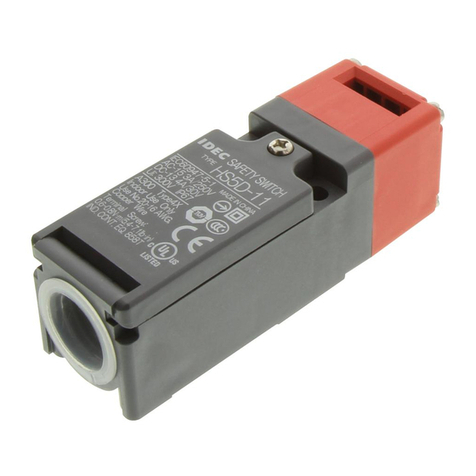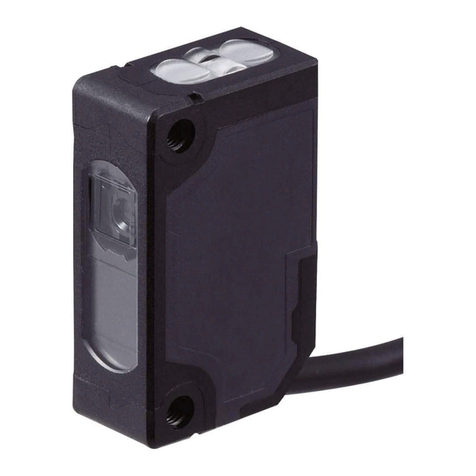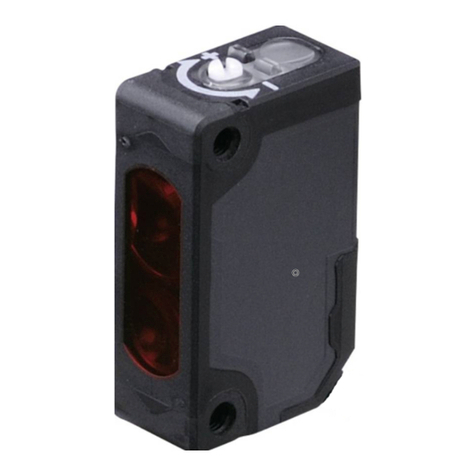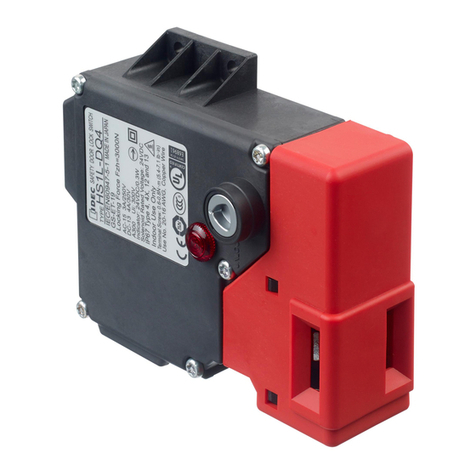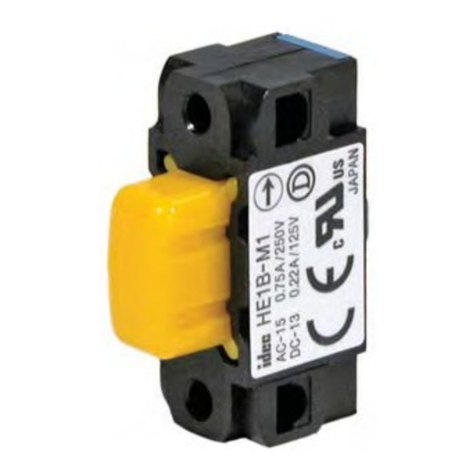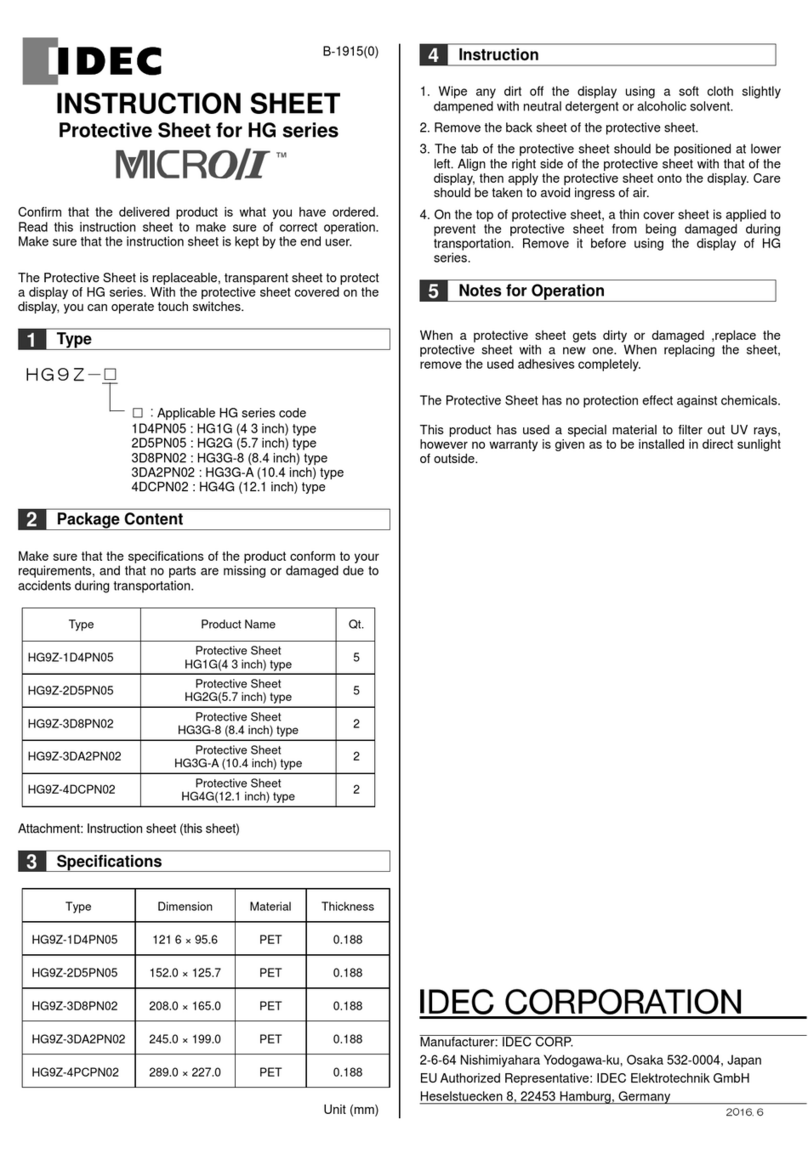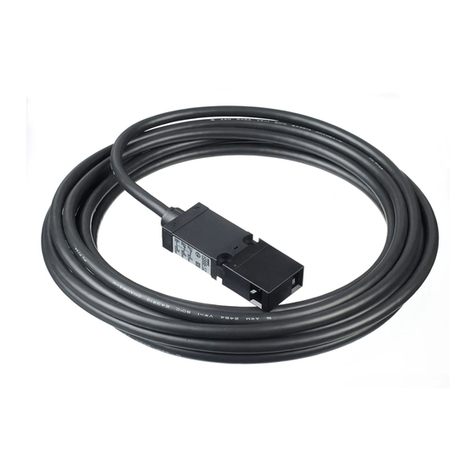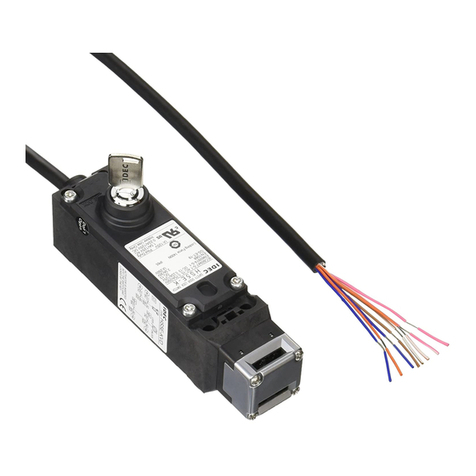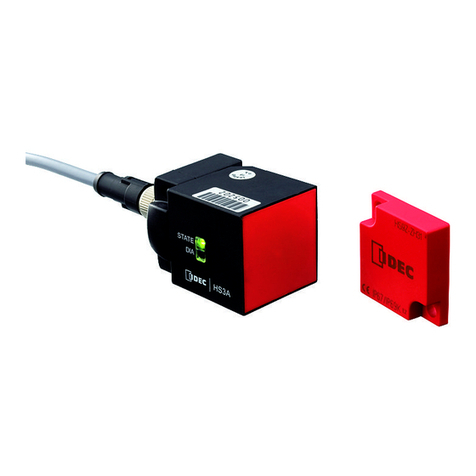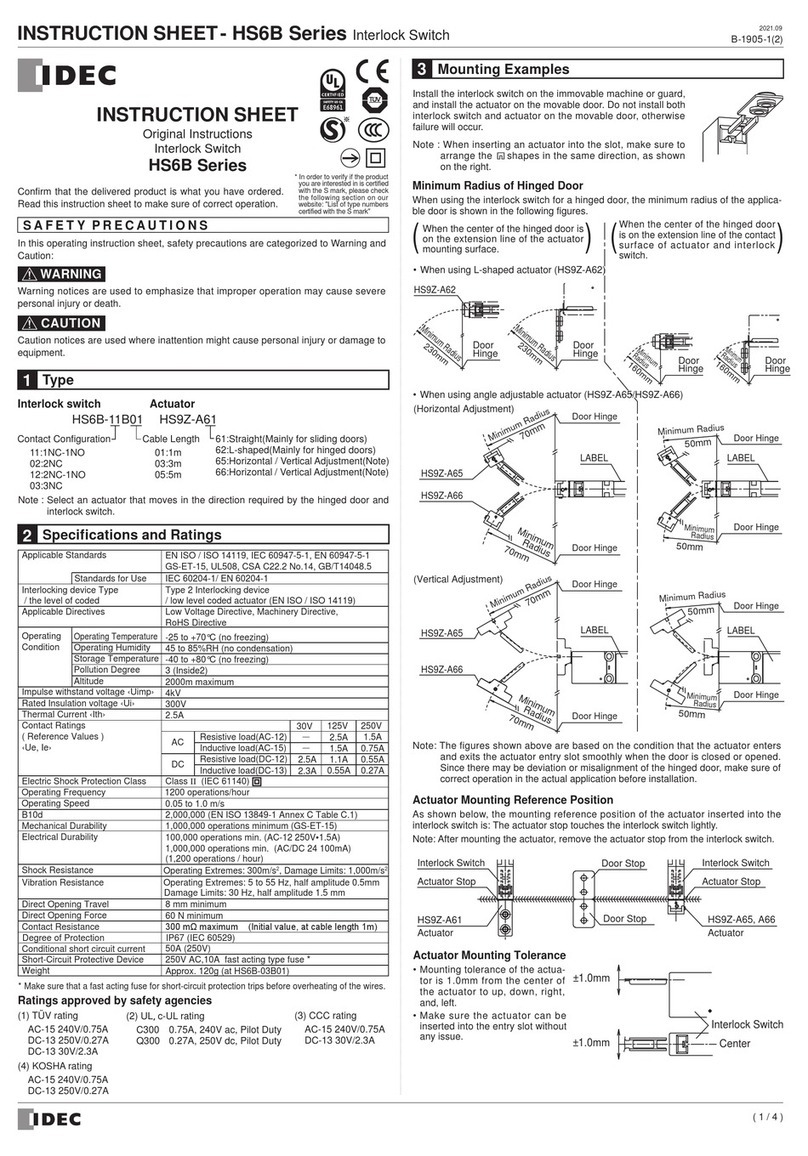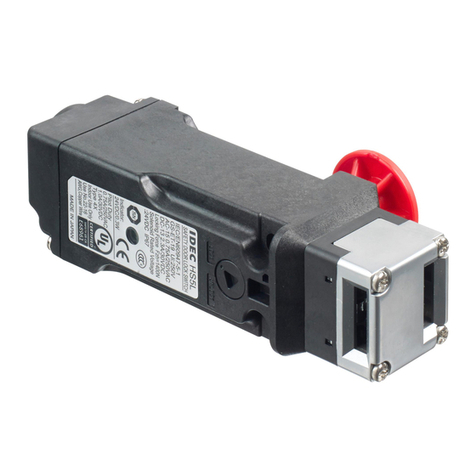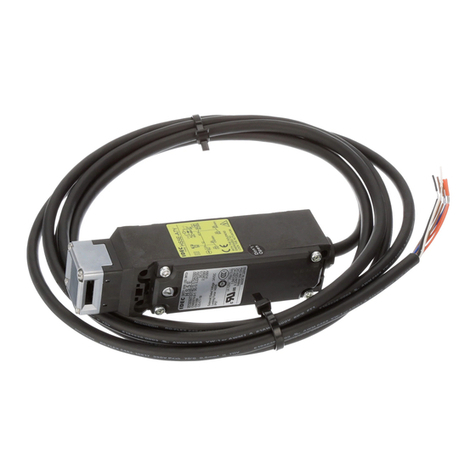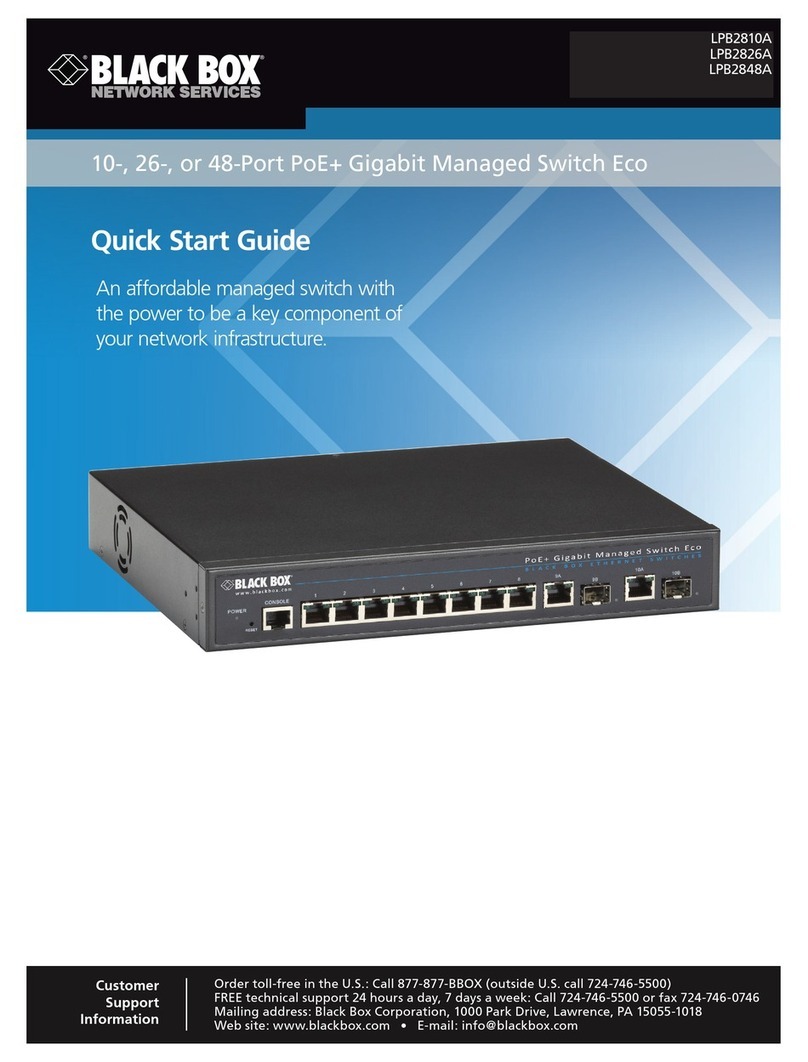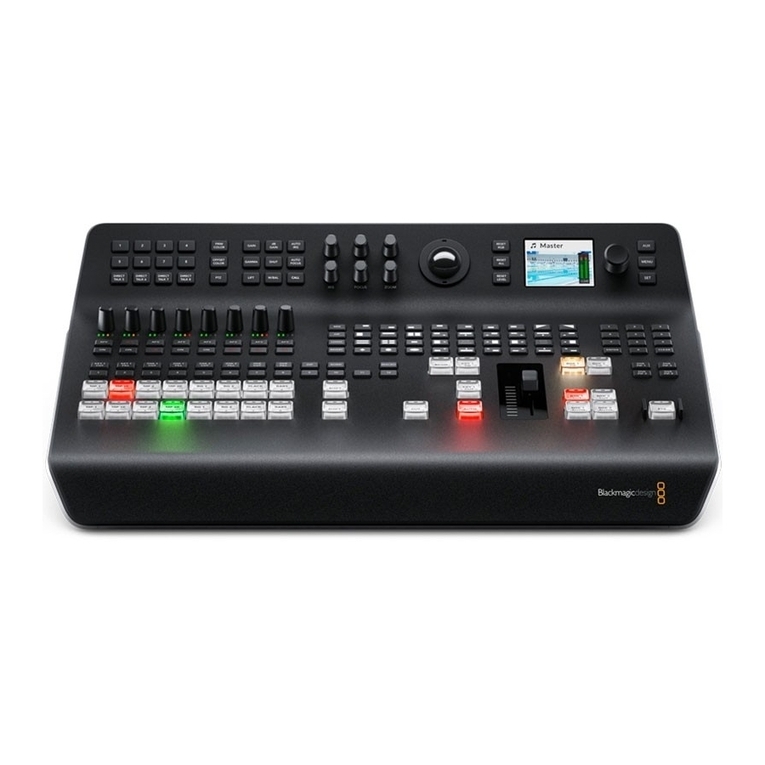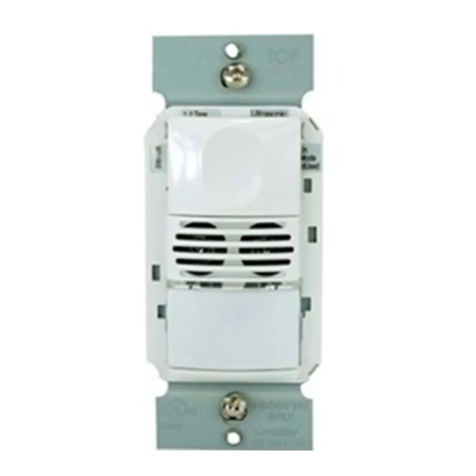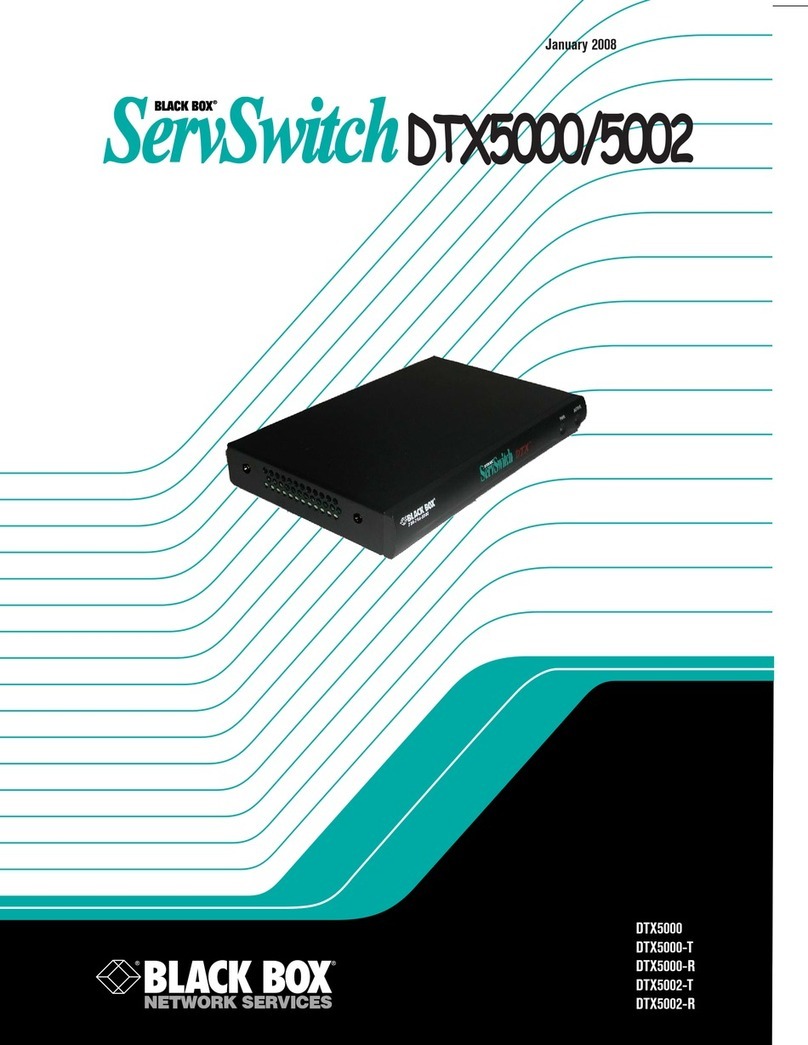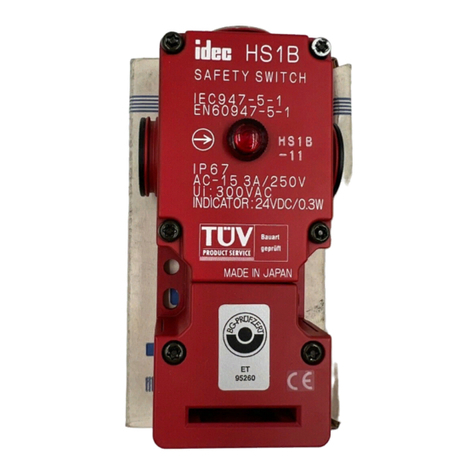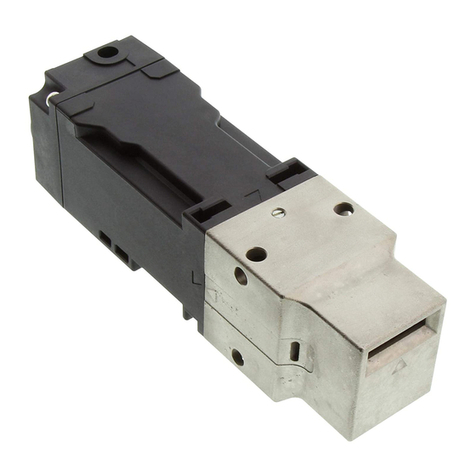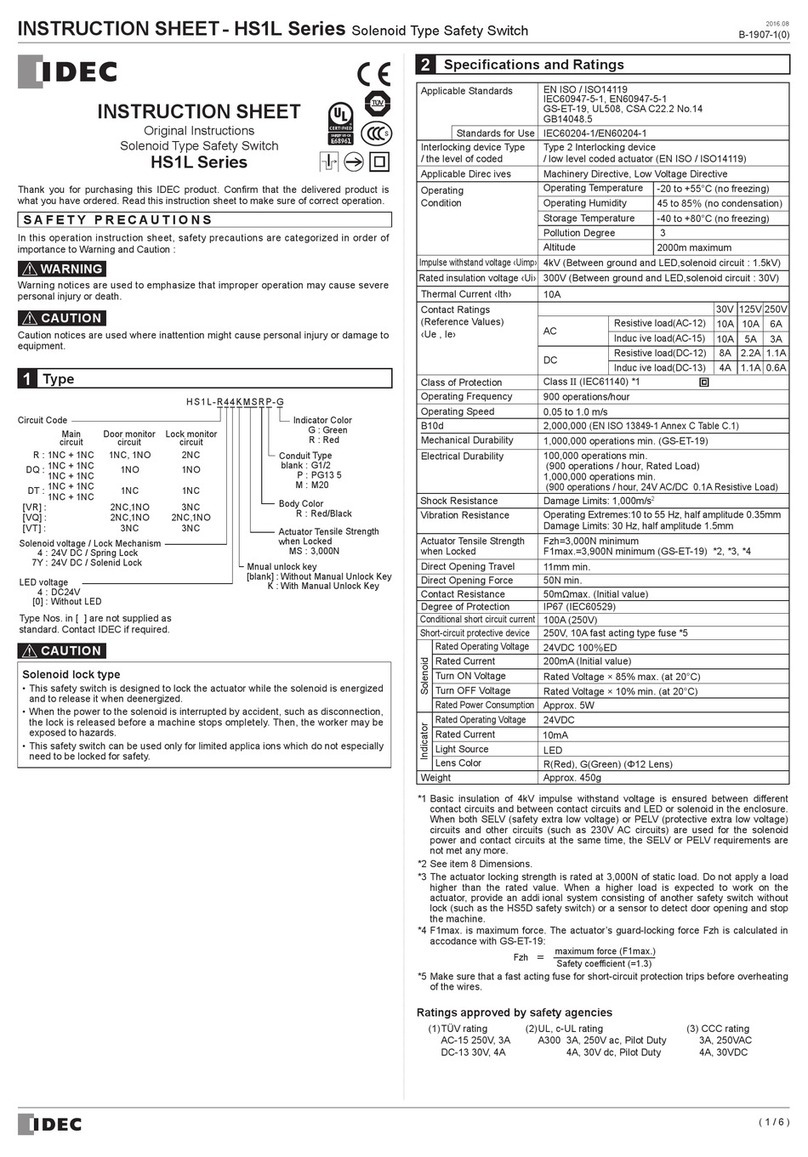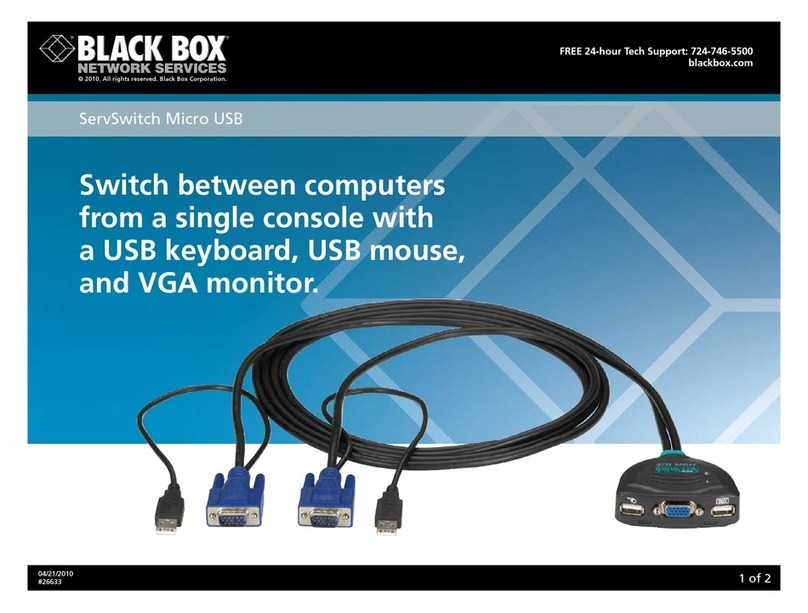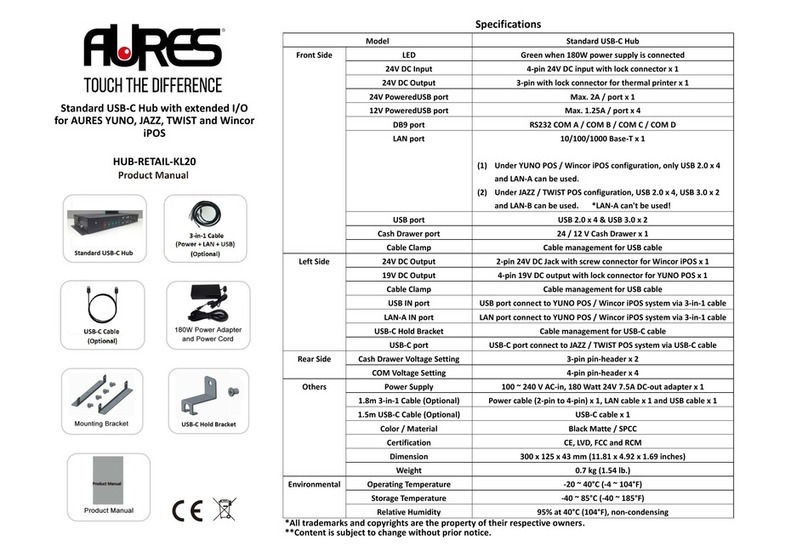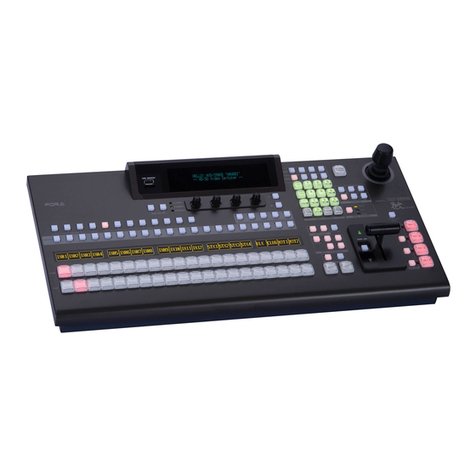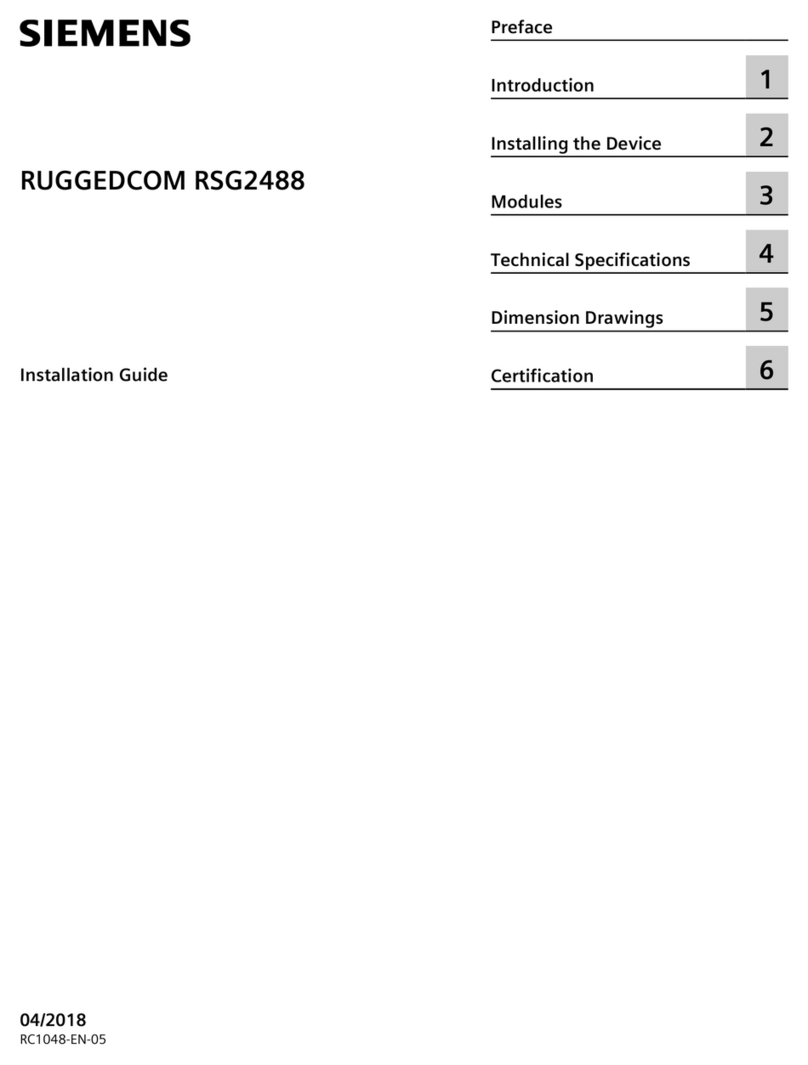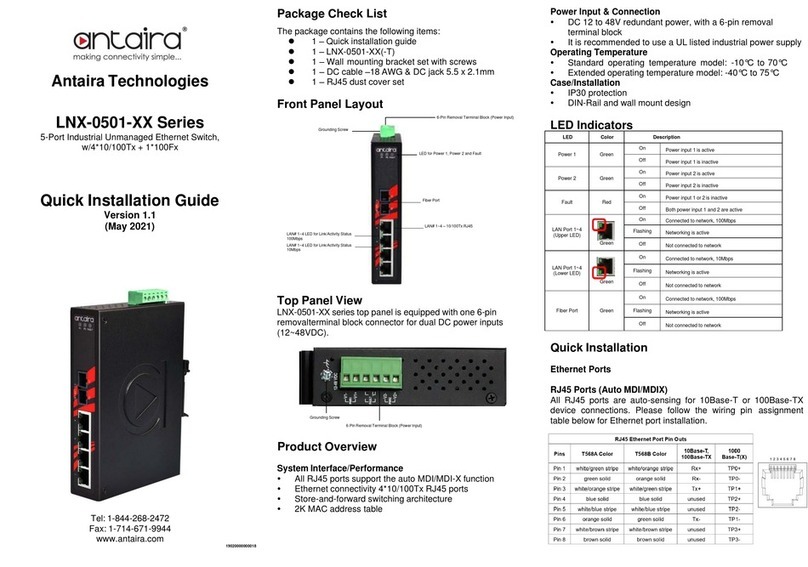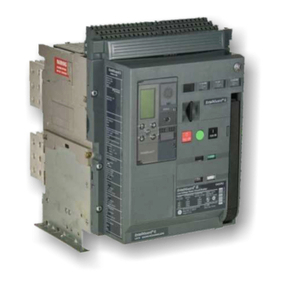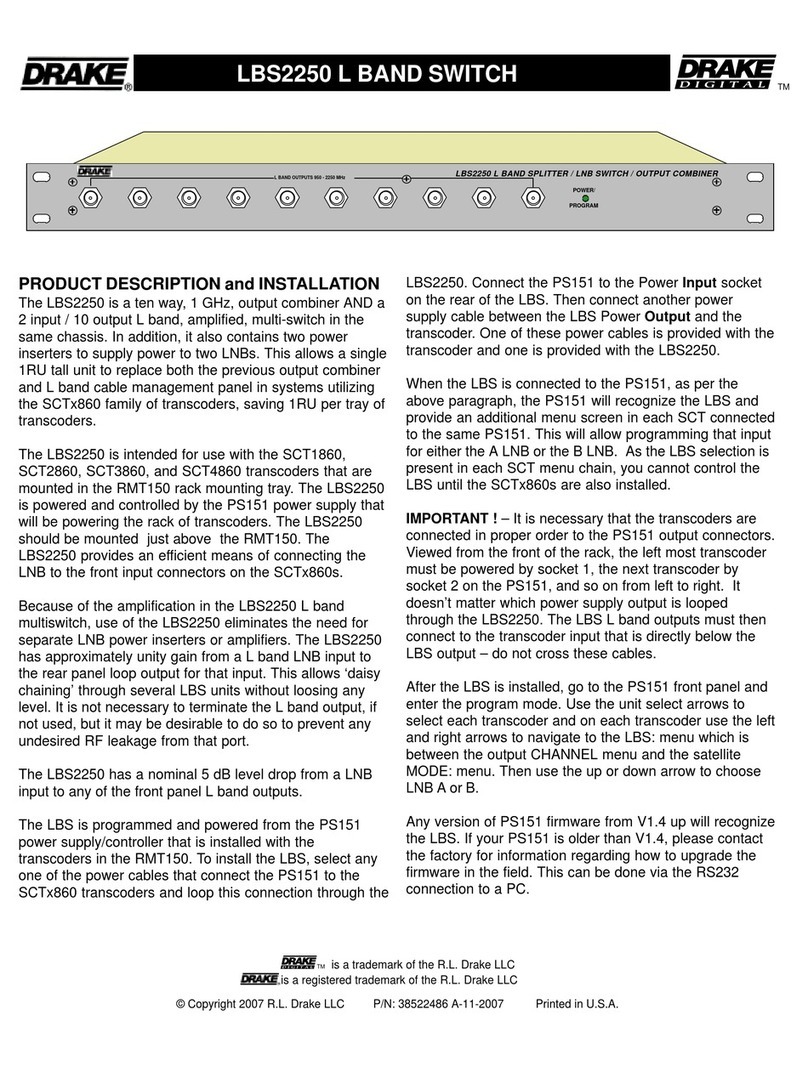
B-1715(3)
INSTRUCTION SHEET - HS5L Series Solenoid Type Safety Switch
( 3 / 8 )
2016.04
4Precautions for Operation
(Actuator deviation) + (Door movement)
≤ 3.3mm
≤ 4.6mm
≤ 5.6mm
≤ 4.6mm
HS9Z-A51
HS9Z-A52
HS9Z-A51A
HS9Z-A52A
HS9Z-A53
HS9Z-A55
For Mounting
• Do not apply an excessive shock to the safety switch when opening or closing the
door. A shock to the safety switch exceeding 1,000 m/s2may cause failure.
• Provide a door guide, and ensure that force is applied on the safety switch only in
the actuator insertion direction.
• Do not pull the actuator while it is locked. Also, regardless of door types, do not use
the safety switch as a door lock. Install a separate lock as shown in section 3.
• Entry of foreign objects in the actuator entry slot may affect the mechanism of the
switch and cause a breakdown. If the operating atmosphere is contaminated, use a
protective cover to prevent the entry of foreign objects into the switch through the
actuator entry slots.
• Make sure to install the product in a place where it cannot be damaged. Make sure
to conduct a proper risk assessment evaluation before using the product, and use a
shield or a cover to protect the product if need be.
• While the solenoid is energized, the switch temperature rises approxi-
mately 40°C above the ambient temperature (to approximately 95°C
while the ambient temperature is 55°C). Keep hands off to prevent
burns. If cables come into contact with the switch, use heat-resistant
cables.
• Solenoid has polarity. Be sure to wire correctly. Do not apply voltage that exceed the
rated voltage, otherwise the solenoid will be burnt out.
• Do not fasten and loosen the conduit at the bottom of the safety switch.
• Use the dedicated actuators only. Other actuators will cause damage to the switch.
• Be careful not to injure yourself with the screwdriver tip when wiring the terminals.
• Be careful not to damage the square-shaped screwdriver port when inserting the
driver into it in order to wire the terminals. Inserting the screwdriver with too much
strength may damage the product.
• Before using the following accessories, be sure to refer to the instruction manual for
the respective accessory and follow the instructions in the manual to ensure correct
use.
HS9Z-DH5 / HS9Z-EH5 / HS9Z-SP51 / HS9Z-SH5 / HS9Z-BA5 / HS9Z-FL5
• HS5L Series Safety Switches are Type 2 low-level coded interlocking devices (EN
ISO / ISO14119). The following system installation & mounting instructions are EN
ISO / ISO14119 requirements to prevent function failure from the interlock switch.
1. Using permanent fixing methods (e.g. welding, rivets, special screws...etc) to
prevent dismantling or de-positioning of the interlock device. However, perma-
nent fixing methods are not an adequate solution if you expect the interlock
device to fail during the machinery lifetime, or if you need to replace the prod-
uct in quick manner. In these situations, other measures (see 2.) should be put
in place to reduce the risks of function failure.
2. At least one of the following measures should be applied to prevent function
failure.
(1) Mounting the interlock device in a place out of reach from workers
(2) Using shielding protection to prevent physical obstruction of the device
(3) Mounting the interlock device in a hidden position
(4) Integrate status monitoring & cycling testing of the device to the control
system to prevent product failure.
• Regardless of door types, do not use the safety switch as a door stop. Install a
mechanical door stop to the end of the door to protect the safety switch against
excessive force.
• Mount the actuator so that it will not hit the operator when the door is open, other-
wise injury may be caused.
• Pay attention to the management of spare actuator. Safety function of door inter-
lock switch will be lost in case the spare actuator is inserted into the interlock
switch. Ensure that the actuator is firmly fastened to the door (welding, rivet, special
screw) in the appropriate location, so that the actuator cannot be removed easily.
• Do not cut or remodel the actuator, otherwise failure will occur.
• If multiple safety components are wired in series, the Performance Level to
ISO13849-1 will be reduced due to the restricted error detection under certain
circumstance.
• The insulation of the cable has to withstand environmental influences.
• The entire concept of the control system, in which the safety component is
integrated, must be validated to ISO13849-2.
(Type HS5L-□4)
The HS5L allows manual unlocking of the actuator to precheck proper door operation
before wiring or turning power on, as well as for emergency use such as a power
failure.
(Type HS5L-□7Y)
If the actuator is not unlocked althoug the solenoid is deenergized, the actuator can
be unlocked manually.
• Before manually unlocking the safety switch, make sure the machine has come to a
complete stop. Manual unlocking during operation may unlock the switch before the
machine stops, and the function of safety switch with solenoid is lost.
• While the solenoid is energized, do not unlock the actuator manually (solenoid lock
type).
• Do not apply excessive force (0.45 N•m or more) to the manual unlock key. Otherwise
the manual unlock switch will be damaged. Do not attach the key to the switch
intentionally ( he key is designed to fall off when the operator's hand is off the key).
• Do not leave the manual unlock key attached to the switch during operation. This is
dangerous because the switch can always be unlocked while the machine is in
operation.
• When there is a displacement of safety switch and actuateor, the actuator may hit the
entry slot of safety switch hardly, thus damaging the entry slot and acutuator. The
rubber cushions on the HS9Z actuator prevent the actuator from damaging the entry
slot by absorbing the shock with movement flexibility. Do not, however, exert
excessive shocks, otherwise the failure of safety switch may be caused.
• The rubber cushions may deteriorate depending on the operating enviroment and
conditions. Immediately replace the deformed or cracked rubber cushions with new
ones.
For Type HS9Z-A51A/A52A actuator
Name or Use
For mounting the safety switch (M4 screw) *7
For mounting the cover(M3screw)
For mounting the HS5L head (M3)
For mounting the rear unlock button
(M3 sems screw)
For mounting the actuator
(HS9Z-A51: two M4 screws) *7
(HS9Z-A52: two M4 Phillips screws)
(HS9Z-A51A/A52A: two M4 screws) *7,8
(HS9Z-A53: two M6 screws) *7
(HS9Z-A55: two M4 screws) *7
Screw Tightening Torque
1.8 to 2.2 N•m
0.5 to 0.7N•m
0.9 to 1.1 N•m
0.5 to 0.7 N•m
1.8 to 2.2 N•m
0.8 to 1.2 N•m
1.0 to 1.5 N•m
4.5 to 5.5 N•m
1.0 to 1.5 N•m
Recommended Screw Tightening Torque
HS9Z-A52
HS9Z-A51
4.6mm
3.3mm
±1.0mm ±1.0mm
Safety
Switch
Center
*7 When the torque is not enough to recommended
screw tightening torque, make sure that the screw
do not become loose by using adhesive sealants
etc. to keep right operation and mounting
positioning.
*8 In the case of HS9Z-A51A and HS9Z-A52A, using
two M4 screws and two attached washers, fasten
the actuator securely on the door.
M4 Screw
Washer
Rubber Cushion
Door
M4 Mounting Hole
• To change the normal position to the
manual unlocking position as shown
above, turn the key fully (90 degrees)
using the special key included with the
switch.
• Using the switch with the key being not
fully turned(less than 90 degrees) may
cause damage to the switch or errors.
• When manually unlocked, the switch will
keep the main and lock monitor circuit
disconnected and the door unlocked.
For Manual Unlocking
Normal
Position Manual
Unlocking
Position
Manual Unlock Key
attached to the
safety switch
Manual Unlock Key Hole
For the Rear Unlock Button
(Type HS5L-□L)
• The rear unlock button is used for an emergency escape when the
orker is confined in the safety hedge (the dangerous area).
(The rear unlock button is according to EN ISO / ISO14119,
GS-ET-19)
• The lock is released when he rear unlock button is pressed,
and the door can be opened.
• To return to locked status, pull back the button. While the rear
unlock button is depressed, the main circuit remains open and the
door is unlocked.
The Rear
Unlock Button
Lock
Release
• Turn off the power to the safety switch before starting installation, removal, wiring,
maintenance, and inspection on the safety switch. Failure to turn power off may
cause electrical shocks or fire hazard.
• Do not disassemble or modify the switch. Also do not attempt to disable the
interlock switch function, otherwise a breakdown or an accident will result.








